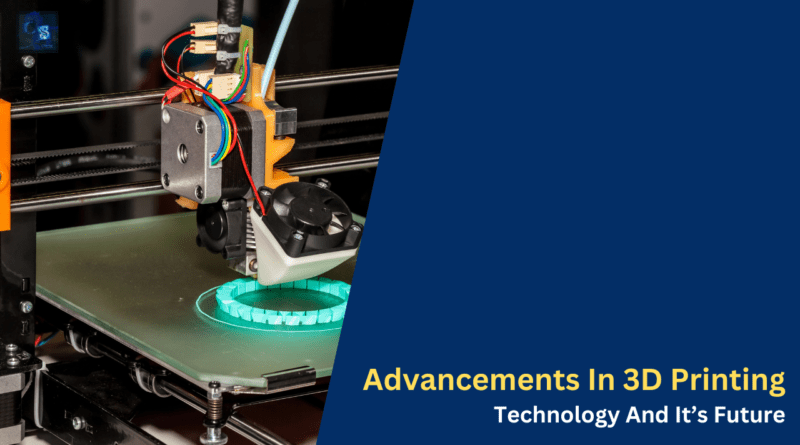Advancements In 3D Printing Technology And It’s Future
Hello, guys, welcome to our blog. Here in this article, we will discuss the advancements in 3D Printing technology, the trends in 3D printing technology, and some interesting facts about 3D printers.
Ask questions if you have any electrical, electronics, or computer science doubts. You can also catch me on Instagram – CS Electrical & Electronics.
Also, read:
- What Is HiL, Hardware In Loop, Working, Tools Used In HiL
- What Is CPC (Common Powertrain Controller) ECU, Working of CPC
- UDS (Unified Diagnostic Services) Tutorials For Automotive Engineers
3D Printing Technology
3D printing, also known as additive manufacturing, has revolutionized the way objects are created, enabling the layer-by-layer construction of three-dimensional structures from digital models. This essay explores the key aspects of 3D printing technology, its applications, advantages, and implications.
01. Technology Overview:
3D printing is an additive manufacturing process that builds objects layer by layer, typically from materials such as plastics, metals, ceramics, or composites. The process begins with a digital model created using computer-aided design (CAD) software. The 3D printer interprets the model and deposits material layer by layer, gradually constructing the physical object.
02. Types of 3D Printing Technologies:
Fused Deposition Modeling (FDM): Utilizes melted thermoplastic filaments deposited layer by layer.
Stereolithography (SLA): Involves curing liquid resin using ultraviolet light to form layers.
Selective Laser Sintering (SLS): Uses a laser to sinter powdered materials, such as plastics or metals.
PolyJet Printing: Jets liquid photopolymer that solidifies layer by layer using UV light.
03. Applications of 3D Printing:
Prototyping: 3D printing is widely used in product development for rapid prototyping, allowing designers and engineers to test and iterate designs quickly.
Customized Products: Industries like healthcare leverage 3D printing for personalized medical implants, prosthetics, and dental devices tailored to individual patient needs.
Aerospace and Automotive: Components with intricate geometries, lightweight structures, and optimized designs are manufactured using 3D printing in aerospace and automotive applications.
Architecture: Architectural models, scale prototypes, and even full-scale building components are created using large-scale 3D printers.
Fashion and Design: Designers use 3D printing to create intricate and unique fashion pieces, accessories, and artistic sculptures.
04. Advantages of 3D Printing:
Customization: 3D printing allows for the production of customized and bespoke products tailored to specific requirements.
Complex Geometries: The layer-by-layer approach enables the creation of complex and intricate geometries that would be challenging or impossible with traditional manufacturing methods.
Reduced Material Waste: Traditional subtractive manufacturing methods generate significant material waste, while 3D printing builds objects layer by layer, minimizing waste.
Rapid Prototyping: Prototyping cycles are accelerated, enabling faster design iterations and reducing time-to-market.
Cost-Effective Low-Volume Production: Ideal for small-batch or low-volume production runs, avoiding the need for expensive molds or tooling.
05. Implications and Challenges:
Materials Limitations: The range of materials available for 3D printing is expanding, but some industries, especially those requiring high-performance materials, face limitations.
Post-Processing Requirements: Depending on the printing technology, post-processing steps may be needed, such as curing, polishing, or support structure removal.
Build Size Constraints: The size of objects that can be produced in a single print may be limited by the build volume of the 3D printer.
Intellectual Property Concerns: The ease of digital replication raises concerns about intellectual property, as the unauthorized reproduction of objects becomes more accessible.
06. Future Trends and Innovations:
Bioprinting: Advancements in 3D printing are paving the way for bioprinting, where living tissues and organs can be printed for medical applications.
Multi-Material Printing: Developing technologies that enable the simultaneous printing of multiple materials in a single object, expanding the range of possible applications.
Sustainability: The exploration of eco-friendly materials and processes to enhance the sustainability of 3D printing.
3D printing technology has evolved into a versatile and transformative tool with applications across various industries. As the technology continues to advance, addressing challenges and exploring innovative possibilities, its impact on manufacturing, design, and customization is set to grow, shaping the future of production methodologies.
Advancements in 3D Printing Technology
3D printing technology has witnessed remarkable advancements, continually pushing the boundaries of what is possible in terms of materials, speed, scale, and application versatility. This essay explores the recent developments that have propelled 3D printing to new heights and expanded its impact across diverse industries.
01. Materials Diversity: One of the significant advancements in 3D printing is the expanding range of materials available for printing. While plastics remain common, innovations include the use of metals, ceramics, biocompatible materials, and even sustainable alternatives like recycled plastics. The diversity of materials enhances the applicability of 3D printing across various sectors.
02. Multi-Material Printing: Advancements in multi-material 3D printing allow the simultaneous deposition of different materials in a single print job. This capability opens up new possibilities for creating complex, multi-functional objects with varying physical properties. Industries such as electronics and healthcare benefit from the ability to integrate diverse materials within a single printed component.
03. Speed and Scalability: Improved printing speeds and scalability have been achieved through innovations in hardware, software, and printing processes. High-speed 3D printers can produce intricate objects faster, making the technology more viable for large-scale manufacturing and reducing production lead times.
04. Large-Scale 3D Printing: Traditional 3D printers were limited in terms of build volume, restricting the size of objects that could be produced. Recent advancements have led to the development of large-scale 3D printers capable of creating full-scale prototypes, architectural components, and even entire building structures. This is transforming industries such as construction and architecture.
05. High-Resolution Printing: Advancements in 3D printing resolution have led to finer details and smoother surface finishes. This is particularly crucial for applications in healthcare, where intricate anatomical models and precise dental implants require high levels of detail and accuracy.
06. Continuous and Composite Printing: Continuous 3D printing, enabled by robotic arms or conveyor belt systems, eliminates the need for layer-by-layer construction. This allows for the production of continuous, seamless structures, reducing print times and enhancing structural integrity. Composite 3D printing combines different materials, reinforcing objects with enhanced strength, flexibility, or conductivity.
07. Bioprinting Breakthroughs: Bioprinting, a revolutionary branch of 3D printing, has seen significant progress. Researchers can now print living tissues and organs using bioinks composed of cells and supportive materials. This has profound implications for regenerative medicine, transplantation, and drug testing.
08. Industry-Specific Applications: Industries such as aerospace and healthcare are leveraging 3D printing for specialized applications. In aerospace, lightweight and intricately designed components are produced, while in healthcare, patient-specific implants and prosthetics are customized for optimal fit and function.
09. Artificial Intelligence Integration: The integration of artificial intelligence (AI) in 3D printing processes enhances design optimization, process monitoring, and quality control. AI algorithms analyze data in real time, improving efficiency and ensuring the production of high-quality prints.
10. Sustainability Initiatives: 3D printing is increasingly aligning with sustainability goals. Innovations include the use of recycled materials, biodegradable filaments, and energy-efficient printing processes, contributing to a more environmentally friendly approach to manufacturing.
The recent advancements in 3D printing technology underscore its transformative potential across various industries. From materials innovation to scaling up production capabilities, these developments are reshaping the way we design, manufacture, and interact with objects, opening doors to new possibilities and applications. As research and innovation continue, the evolution of 3D printing promises even more breakthroughs in the future.
Trends in 3D printing technology
The field of 3D printing, also known as additive manufacturing, continues to evolve rapidly, driven by technological innovations and emerging market demands. This essay explores key trends shaping the trajectory of 3D printing technology and its applications across diverse industries.
01. Continuous Advancements in Materials: One prominent trend is the continuous expansion of available materials for 3D printing. Beyond traditional plastics and metals, researchers are developing new materials, including biodegradable polymers, advanced ceramics, and composites. This diversification enables a broader range of applications, from medical implants to aerospace components.
02. Sustainable 3D Printing Practices: Sustainability is becoming a focal point in 3D printing. Manufacturers are increasingly adopting eco-friendly practices, such as utilizing recycled materials, reducing waste through optimized printing processes, and exploring bio-based materials. Sustainable 3D printing aligns with global efforts to minimize environmental impact.
03. 4D Printing: The concept of 4D printing introduces an extra dimension—time. 4D-printed objects can change shape or properties over time in response to external stimuli, such as temperature or humidity. This dynamic aspect holds promise for applications in smart materials, self-assembling structures, and responsive medical implants.
04. Integration of Artificial Intelligence (AI): AI is playing a pivotal role in enhancing the efficiency and capabilities of 3D printing. Machine learning algorithms optimize designs, predict potential printing errors, and improve overall print quality. The integration of AI-driven generative design tools is empowering engineers to create complex structures that were previously challenging to conceive.
05. Hybrid and Multi-Material Printing: Hybrid manufacturing combines traditional methods with 3D printing to leverage the strengths of both. Multi-material 3D printing, involving the simultaneous use of various materials in a single print job, is gaining traction. These trends enhance the versatility of 3D printing for creating complex, functional objects with diverse properties.
06. Increased Speed and Scalability: Advances in printing technologies and hardware are addressing historical limitations related to speed and scalability. High-speed 3D printers and large-scale printing capabilities are making additive manufacturing more viable for mass production in industries like automotive and consumer goods.
07. Point-of-Care 3D Printing in Healthcare: In healthcare, the trend is shifting toward point-of-care 3D printing. This involves producing patient-specific medical devices, implants, and models directly at healthcare facilities. Customization, reduced lead times, and improved patient outcomes are driving this trend.
08. Aerospace Innovations: The aerospace industry is witnessing significant advancements in 3D printing, especially for manufacturing lightweight components with complex geometries. Engine parts, aircraft interiors, and structural components are increasingly being produced using additive manufacturing techniques.
09. Adoption of 3D Printing in Construction: 3D printing is making inroads into the construction industry, where large-scale printers can create entire building structures. This trend holds promise for faster and cost-effective construction methods, with applications ranging from housing to infrastructure development.
10. Open-Source 3D Printing: The open-source approach to 3D printing is gaining popularity, fostering collaboration and innovation within the maker community. Open-source hardware and software initiatives contribute to the democratization of 3D printing technology, making it more accessible to a broader audience.
In conclusion, the trends shaping 3D printing technology reflect a dynamic landscape of innovation and application expansion. As the industry continues to evolve, these trends are poised to drive further advancements, unlocking new possibilities and transforming how products are designed, manufactured, and consumed across various sectors.
This was about “Advancements in 3D Printing Technology “. Thank you for reading.
Also, read:
- Advancements In Power Electronics For Energy Efficiency
- Exploring Electric Vehicles: Technology and Challenges
- The Future of Power Systems: Smart Grids
- What is XCP (Universal Measurement and Calibration Protocol)? Introduction, Working, Purpose, Applications
- What Is SIL Testing, Software-In Loop, Working, Purpose
Author Profile
- Content Writer








